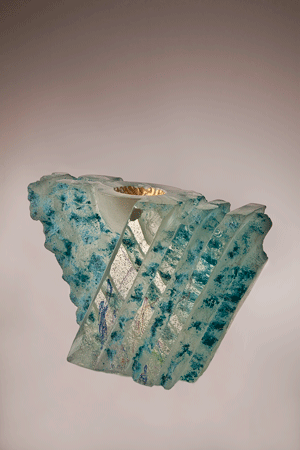Fused: Richard Morrell
Fused: a journey from artists in the National Art Glass Collection

- Richard Morrell Bowl of Balance 1990, furnace cast, acid etched and polished
Cultural Background
Both my parents were English, the family name comes from French/American ancestry, through a migration to England in the 1800's
Place of Origin
Banstead, United Kingdom
Start of Migration Journey
London, United Kingdom - November 1979
Place of Arrival in Australia
Tullamarine Airport, Melbourne - November 1979
First Home in Australia
Oakleigh, Victoria
First job in Australia
Tutor in Glass Studies, Caulfield Institute of Technology (now Monash University)
Other Jobs in Australia
1982-2001 Self employed professional artist
2001-2005 Designer/Workshop Manager, Jenggala Ceramics (Glass division)
July 2005 Returned to Australia to manage own studio again
Richard's story
My mother was a Londoner while my father was a Yorkshireman. They met and married in London, I was born in Banstead and raised in Tadworth, both just south of London.
After a chequered early career, I attended West Sussex College of Design in 1975, then on to Stourbridge School of Art in 1976 for three years. I attained a BA (Hons.) in 3D Design. Stourbridge is the center of the English crystal glass industry, and I was fortunate to learn my skills from craftsmen with generations of experience.
While at college I was interviewed for a tutor's position at Caulfield Institute of Technology (now Monash) in Melbourne, it took six months for them to get back to me, and I had three weeks to get over here. They were looking for someone to run the glass department and they advertised through colleges in America and England. One of the lecturers at Stourbridge said that it would be the perfect job for me because of my engineering background. Caulfield needed someone who could not only blow glass and teach but also had to be able to build the equipment, at that time it was not possible to just go out and buy what you needed.
In 1979 I arrived in Australia as a Temporary Resident and taught at Caulfield Institute until 1981.During this time I applied for permanent residency status under an amnesty for illegal immigrants; even though I was legal I still qualified. I worked at Caulfield Institute with Julio Santos. Together, we helped to launch the careers of many professional glass artists. Tiring of the restrictions of being a full-time teacher, I left Caulfield Institute and in 1982 funded and built my own studio in a space rented from the Meat Market Craft Centre in Melbourne. I stayed there for six wonderful creative years.
In 1988 I moved to Coburg where I again set up and managed my own studio. Around that time I was an external assessor at Monash University for about six years, and also did a residency as 'visiting artist' at the University of South Australia. I have always tried to keep a connection with education. Though I did not want to teach full time, I always felt that I had something to contribute in that area. In 1995, I sold up the Coburg studio and moved to Castlemaine in rural Victoria to set up my dream studio and gallery in a hundred and fifty year old building there. I hoped this would be my last move.
It was not to be! In 2001, I received a 'phone call from Brent Hesselyn, the owner of Jenggala Ceramics in Bali. He asked if I was available to go over and help them start a glass making division. It was at the right time for me personally, I needed a break, and three weeks later I was working in Bali, where I stayed nearly four years. Jenggala produces custom made ceramics for the world's hospitality industry. My job was to build and set up the glass studio, and design a range of glassware for production. Also, I had to train the Balinese guys to make the glass, which was a treat as they are so good with their hands. By mid 2005, I felt my job there was done. Though a wonderful experience, factory life was not really for me, my own artwork was suffering. Thus I returned to my Castlemaine studio, bringing my Indonesian wife, Pipit, with me. This has been my only marriage.
I love the space Australia offers, everywhere else is so crowded, and of course the weather is great. I also like the "have a go" attitude of Australian people; this was one of the biggest cultural differences I noticed when I first arrived. In England, if you tried to start a small business or get something happening, no one would go out of their way to give you a hand or support. In contrast, I found Australians were very supportive of anyone making an effort to get ahead or do something different. A good example would be Mark Brabham from Australian Combustion, who I met in 1981; and went miles out of his way to help me set up my first studio. This kind of positive attitude is one of the things that makes Australia such a wonderful place to work and live.